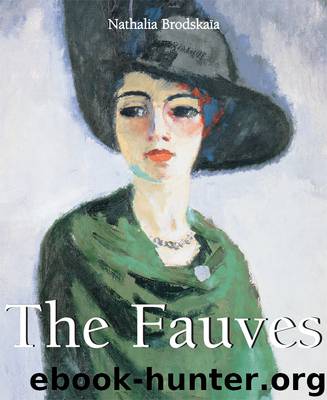The Fauves by Nathalia Brodskaya

Author:Nathalia Brodskaya [Brodskaïa, Nathalia]
Language: eng
Format: epub
ISBN: 9781783103935
Publisher: Parkstone International
Published: 2014-04-07T16:00:00+00:00
Raoul Dufy, The Antibes, 1926.
Gouache and watercolour on paper,
50.6 x 65.5 cm. Pushkin State Museum
of Fine Arts, Moscow.
Raoul Dufy,
14 July in Deauville, 1933.
Oil on canvas, 38 x 92 cm.
Pushkin State Museum of Fine Arts, Moscow.
Raoul Dufy, Portrait of Suzanne Dufy,
the Artist’s Sister, 1904.
Oil on canvas, 46 x 33 cm.
State Hermitage Museum, Saint Petersburg.
It was no mere chance that Dufy produced his own Balle du Moulin de la Galette — the artist had a need to say a similar thing, but in his own, different language. Woman Seated (1904, Hermitage) also comes across as a personal reworking of a motif by Renoir. The fascination of the living world gives way to a light-hearted grotesque thanks to the artist’s decorative imagination. The blues, reds, and oranges resound with full force; the brush draws gently and whimsically on the coloured surface. Here Dufy gave physical expression to the revelation he had experienced on first encountering Matisse’s painting Luxe. Calme et Volupté (1904, Musée d’Orsay, Paris): “Standing in front of that painting, I understood all the new principles of painting,” Dufy said. “The realism of the Impressionists lost its charm for me in contemplation of that miracle of the imagination translated into design and colour.”[51]
The second painting by Dufy, 14 July at Deauville, was donated to the Moscow museum in 1969 by the collector M. Kaganovitch, in whose Paris gallery a Dufy exhibition was held in 1936. A favourite motif of Dufy’s since childhood — the Normandy coast, the sea and ships — is painted in the landscape format often used by the artist. This painting is a concentration of many things: Dufy’s attitude to the natural world and to colour, the poetic nature of his painting, decorativeness, and, most importantly, the feeling of joy which radiates from all his work. The sprinklings of bright colour in the blue milieu — red, white, and yellow flags and the light house — create an impression of a colourful festival or a child’s fairy-tale. At the base of the work is the same pale blue colour in which, according to his biographer, Berr de Turrique, Dufy once painted a wall of his room so as always to have the sky before his eyes. This intense azure lies in a dense layer on the canvas, covering its whole surface and establishing a unity of water, sky, and air.
It is sometimes considered that Dufy was the most Impressionistic among the Fauves. This painting demonstrates once again the course Dufy took in the re-evaluation of Impressionism: the colour of objects does not alter as a result of light or atmospheric phenomena — it is constant and abstract. The dark blue on the water lies above the azure without any vibration — this is not in the least a product of the richness of colour reflexes in shadow, but an abstractly painted surface. In the shadow of the boats this surface becomes grey. The colour on the canvas is not the colour of the object — the patch does not coincide with the contours of the boat.
Download
This site does not store any files on its server. We only index and link to content provided by other sites. Please contact the content providers to delete copyright contents if any and email us, we'll remove relevant links or contents immediately.
The Secret History by Donna Tartt(18161)
Red Sparrow by Jason Matthews(5195)
Harry Potter 02 & The Chamber Of Secrets (Illustrated) by J.K. Rowling(3555)
In a Sunburned Country by Bill Bryson(3367)
Drawing Cutting Edge Anatomy by Christopher Hart(3290)
Figure Drawing for Artists by Steve Huston(3270)
The Daily Stoic by Holiday Ryan & Hanselman Stephen(3110)
Harry Potter and the Prisoner of Azkaban (Book 3) by J. K. Rowling(3109)
Japanese Design by Patricia J. Graham(3000)
The Roots of Romanticism (Second Edition) by Berlin Isaiah Hardy Henry Gray John(2819)
Make Comics Like the Pros by Greg Pak(2758)
Stacked Decks by The Rotenberg Collection(2685)
Harry Potter and the Deathly Hallows (7) by J.K. Rowling(2550)
Draw-A-Saurus by James Silvani(2503)
Tattoo Art by Doralba Picerno(2486)
On Photography by Susan Sontag(2482)
Foreign Devils on the Silk Road: The Search for the Lost Treasures of Central Asia by Peter Hopkirk(2388)
Churchill by Paul Johnson(2362)
The Daily Stoic by Ryan Holiday & Stephen Hanselman(2343)
